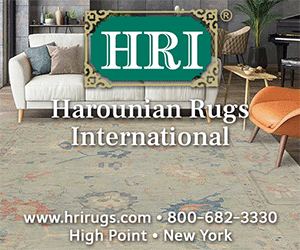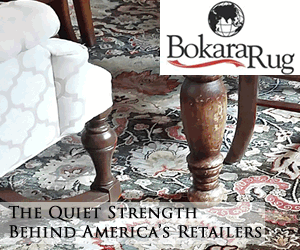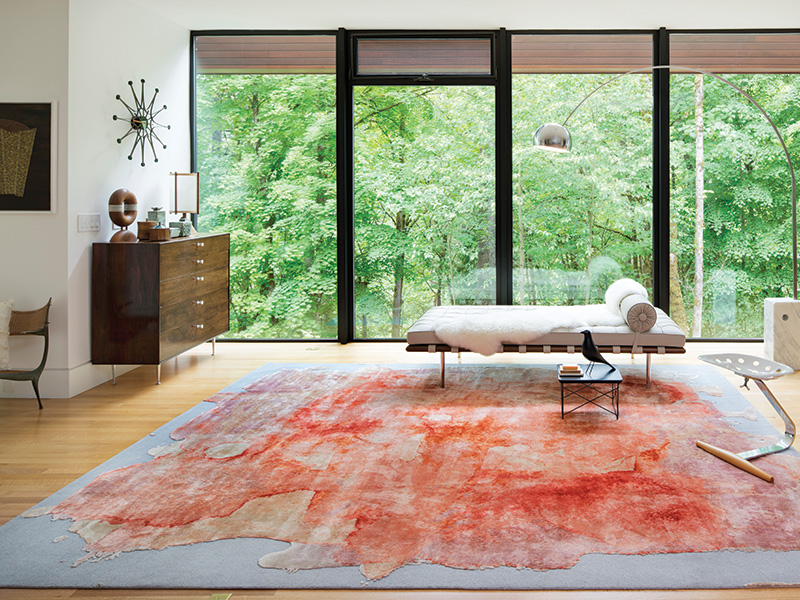In May of 2018 Rug Star and Christiane Millinger Oriental Rugs and Textiles collaborated on the inaugural North American version of Rug Star’s noted ‘Intimacy’ photography series which began in Berlin, Germany. This is a behind the scenes look at the making of “Intimacy Portland”—set in Portland, Oregon—with commentary regarding the effectiveness of such campaigns on the perception of handmade rugs and carpets.
Jürgen Dahlmanns is serious in his playfulness. The expressiveness of his carpets, many of which he describes as “controlled wilderness,” reflect a style that can be youthful while still informed by judgment, experience, and a tasteful eye. Likewise the energy expressed in the advertising photography of his firm Rug Star is carefully choreographed to be as joyful and beautiful as possible, matching of course the energy of the carpets, yet still relatable to consumers who seek carpets more artistic in their expression. There is, so to speak, a sexiness about his aesthetic.
First started in the winter of 2015, ‘Intimacy Berlin’ is an ongoing photography series which places Rug Star carpets in the real homes of residents of that city in order to produce advertising and marketing materials, including the firm’s “Intimacy Berlin” Magazine, a self produced pulp publication highlighting the carpets in high-style dynamic and tempting in situ room settings. The first homes used were those of close friends and associates of Dahlmanns,’ but as word of the series — and the noteworthy carpets — spread, so too did the scope of the homes featured and the eventual outcome of the shoots. Now the homes are specified and found by word of mouth, and instead of solely producing visually striking photography, the shoots now also typically result in sales, of the carpets photographed, to the homeowner. Often with homeowners now requesting a shoot and sales experience as it were. It is a mutually beneficial and efficient situation that meets not only the many needs of Rug Star but as it has evolved, the needs of consumers as well.
When I first heard of Dahlmanns’ plan to expand upon this series by shooting the inaugural North American version in Portland, Oregon I proposed accompanying Dahlmanns on the shoot in order to write this article. This is a written look behind the scenes that examines the intentionality of great design and Jürgen Dahlmann’s approach to marketing rugs and carpets in the present and the near future.
The entire “Intimacy Portland” photography series was shot over ten days in May of 2018, in partnership with Rug Star’s Portland dealer and friend, Christiane Millinger, proprietress of the the eponymous Christiane Millinger Oriental Rugs and Textiles. Millinger is a noted fixture in the Portland rug and textile scene and due to her active educational and civic involvement, well connected with those owning homes suited to the “Intimacy” concept. Working remotely in close collaboration with Dahlmanns, Millinger scouted locations for the series, arranged additional help, meals, vetted photographers, and provided accommodations for Dahlmanns and me; an indispensable component of the success of Intimacy Portland.
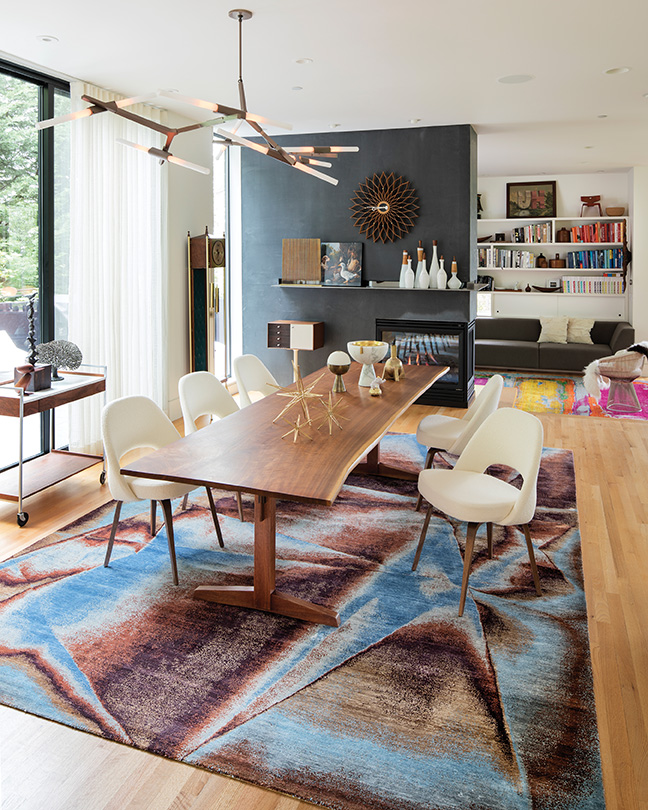
Dining Room of The Hoke House as styled for “Intimacy Portland”.
WHEN WORKING IN UNFAMILIAR ENVIRONMENTS, CONSIDER A LOCAL BUSINESS PARTNER.
Due to a confluence of fate and timing, I was fortunate enough to accompany “Intimacy Portland” on the initial day of photography in what can be considered the most architecturally significant home of the entire series. The John and Karen Hoke House in Portland was designed by Skylab Architecture and completed in 2012. Nestled on a sloped site among the trees, the home embraces primitive materials in sophisticated applications and through the extensive use of broad fenestration welcomes the outdoors in. Due to its prominent former use as both a television and movie set, the home draws fans daily who pose for selfies at the end of the driveway. This is the academic and pop-culture credibility of the home that serves as the stage, and property closet, for the first day of shooting. All the photographs accompanying this article were shot therein.
WHEN SEEKING TO SHOWCASE AN UPMARKET PRODUCT, CHOOSE A STAGE OF APPROPRIATE CALIBER.
It is the morning of the shoot and Dahlmanns and Millinger have arrived at Millinger’s shop to load the rugs and carpets. I am but a casual observer intent on documenting what makes this campaign successful, but old habits die hard. Within minutes of exchanging pleasantries I am helping load carpets and, after discovering that the crew is short a licensed driver, also become an impromptu chauffeur for Dahlmanns, a rug porter, and a van full of rugs. This is to be the dynamic for the day of the shoot; Dahlmanns as leader, Millinger as liaison, Christie as observer and, along with several unnamed others, occasional spare hands.
MAKE SURE YOU HAVE ENOUGH LICENSED DRIVERS.
“Now we make the photo!” says Dahlmanns for the first of many times as the initial vignette is readied for photography. Dahlmanns has consulted with photographer Laurie Black regarding which room to begin with in the home. Lighting is critical and after a cursory review of all the spaces being shot that day, Black has determined it is imperative to catch the dining room in the morning light. After carefully documenting via iPhone the placement of all of the homeowners’ belongings in the space, the crew works to strip the room back in order to once again build it up. Rather than be styled for daily living, the room must be styled for maximum visual effect; one that showcases the carpet first and the equally dramatic space second. “Don’t think of it as selling rugs though Michael,’ says Dahlmanns, “Think of it as an installation.” This is what Dahlmanns does. He installs, confidently and intentionally.
Typically on a photoshoot for a firm such as Rug Star there would be many layers of creative input involved; production designers, stylists, and marketing people, to name but a few. ‘It is a great joy to be working with Jürgen.’ says Black later in the shoot before continuing, “On so many of these shoots there can be friction between the various creatives, but not with Jürgen [who acts as his own stylist.] He has a visual style, he knows what he wants, and he knows how to get there.” Part of getting there is the stripping back, but so is the initial “making of the photo,” as Dahlmann’s would say in slightly improper English best described as “not wrong.” And so it is that the first photo made was of a room stripped down, placement of furnishings unsure, and rug not fully decided. “We make the photo so we can see what the camera sees.” explains Dahlmanns, “This way we know if we have to move or remove objects to fit in or out of the photo, or see how the rug is lying in the space.” Over the course of the next hour or so many photos are taken, each moving one step closer to the final dining room shot shown here. The final shot of each room is less dramatic than one might imagine; a simple pause, crew strategically out of frame and out of the light and then a barely audible “click” and it’s time to reset the room(s) for the next shot.
TRIAL AND ERROR LEADS TO A MUCH BETTER FINAL RESULT.
An architect by training, Dahlmanns possess a keen grasp of defining space, either architecturally —”Isn’t this home just ‘Wow!’?” he asked me as we had pulled up the driveway—or through interior furnishings such as rugs; a rug in the middle of a large or open concept space will define an area, for whatever use. One of the problems as Dahlmanns sees it is in “communicating the product,” which is to say conveying the essence or the “soul of the carpet.” “Even cheap carpets look good in photography.” boldly asserts Dahlmanns, who continues, “Handmade often doesn’t look any better. This is the challenge we try to overcome with “Intimacy Berlin” and now of course “Intimacy Portland.’’ One secret— well it would be a secret if it were not visible to everyone who has seen an “Intimacy” series photograph—is that at least one corner of the rug is cropped out. This brings the observer—and potential rug buyer—into the space visually, looking around the space as opposed to from the outside looking in. A small but important detail that contributes to the success of this campaign.
SUCCESS IS IN THE DETAILS.
A detail of particular note is that while each of these photographs is carefully styled, nothing, except the Rug Star carpets, is brought into the home. Every accessory, every accoutrement of better living, everything belongs to the homeowner and helps subtly to humanize the spaces. Not that objects are left in place; rather the entire home becomes a prop room of sorts. As the shoot moves through the house, it is styled by Dahlmanns’ confident, direct, sure, stylish eye in his role as stylist, art director, and more.
The Hoke House is filled with an array of important works of design and art. Some pieces, such as the original Eames Lounger (shown on page 40), or the George Nelson designed clock (shown on page 36)—of which there are many in the home—are iconic, whereas others, such as a collection of primitive pottery, are more reflective of “good or intentional design” as a matter of concept, principal, and execution rather than renown. This mix carries throughout the home and informs the style of the photographs, imbuing a sense of American vernacular to the series.
“We must get the rugs in front of clients.” says Dahlmanns, explaining the reason behind the original “Intimacy Berlin” series. A difficulty he discovered, however, was that the visuals and aesthetics of arguably quite stylish homes in Berlin fail to resonate with North American consumers. Thus, the regionally produced series was conceived, and with Millinger, “Intimacy Portland” born.
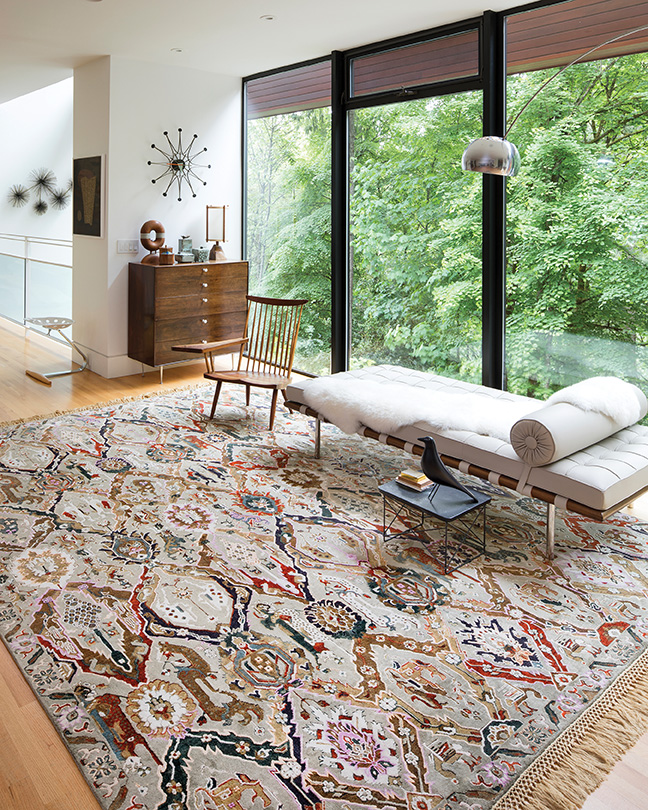
Living Room of The Hoke House as styled for “Intimacy Portland”.
KNOW YOUR AUDIENCE
“In normal everyday life there is the chase to earn a living,” responds Millinger to being asked her thoughts on the project after the first room was completed. “A project such as this … is an opportunity to be creative and to be with friends, in beautiful spaces, and to create beauty.” Millinger believes with utmost passion that the pursuit of beauty can drive life forward more than the simple quest for money. That is not to say there are not financial concerns, far from it, but it is to say that better results—both visually and mentally—can be achieved when aesthetics share at least equal footing with monetary concerns.
Having just completed writing the articles “The Rugs and Carpets of Fallingwater,” and “The Wright Look” (RUG INSIDER, Mid-Century Modern | Summer 2018, pages 34-39 and 41-43), some of Frank Lloyd Wright’s words came to mind. I wondered about the notion that the mechanization of design favors the mediocre, the average. Millinger retorts “Not mediocre but utilitarian. You don’t have to stay mediocre.” Millinger and I exchange a few more thoughts on design and taste before she concludes the conversation, as all conversations on design must and should conclude, “De gustibus et coloribus non disputandum est,” an ancient Roman adage roughly translating to “In matters of taste and color, there can be no disputes.” And yes, Millinger quoted the passage in Latin.
TASTE IS SUBJECTIVE.
“Success requires setting aside the ego.” says Dahlmanns as the crew takes a break for lunch. “European designers tend to to design to the ego, American designers design to the client. “Intimacy Portland” is about showing my rugs in American interiors.” In a way, some of Dahlmanns ego has been stripped out of the scene, replaced by the aspirations of those who wish their homes to be as beautiful and stylishas those featured in the other “Intimacy” series.
TENSION BALANCES HARMONY.
Dahlmanns and Millinger are both headstrong individuals with a desire to succeed; this much has been apparent throughout the shoot. Dahlmanns is clearly in charge of directing the entire affair, Millinger is the liaison between the demands of the shoot and those of the gracious homeowners who have allowed the use of their home. These can be distinct, and as day gives way to late afternoon tensions arise with the realization that time is running short. “I don’t like to feel the pressure of time.’ says Dahlmanns as the shoot is wrapping, more or less on schedule but tight against the return of the homeowners. For her part, Millinger, naturally concerned with the success of “Intimacy Portland,” is also eager to ensure that everyone involved is happy, particularly the homeowners—her friends and potential clients. Having watched the tension rise, abate, and be forgotten over dinner and drinks later, this writer is reminded of the words of another rug designer (and philosophies the world over). To paraphrase: In order to appreciate the good, one must also endure the bad, or in this case, merely the mildly uncomfortable.
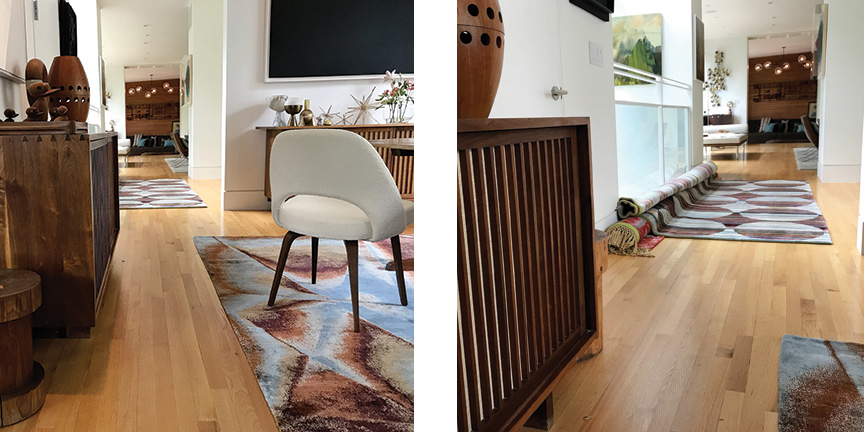
Detail images of the dining room of The Hoke House as styled for “Intimacy Portland”. The left image looks past the dining room sideboard into the hall which appears to feature a runner or scatter sized rug. In reality, as shown on the right, the purported runner is simply a larger rug folded over to give the impression of a completely furnished space. This is just a hint of the magic which is essential to the illusion required in photoshoots such as this.
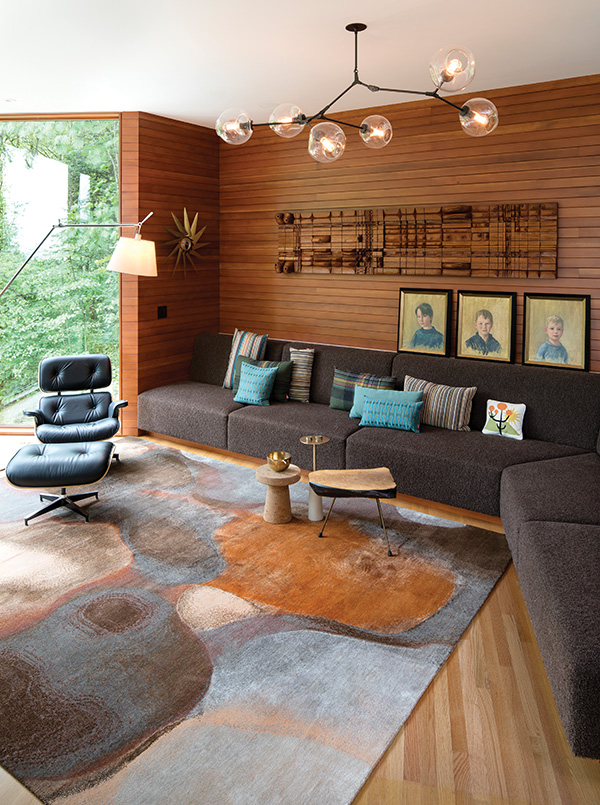
Study of The Hoke House as styled for “Intimacy Portland”.
COLLABORATION IS KEY.
Black has just finished shooting one of the final photographs of the day and announces the set can now be struck. In an instant of inspiration, I suggest we take a photo of Dahlmanns, Millinger and myself. This diverse trio of rug professions, each with our own experiences and perspectives, contributing to the marketing and sales of rugs and carpets. Perhaps reflective of her skills as a photographer, what Black captured perfectly summarizes our individual personalities and our contributions—minor as mine were—to this day’s work. It also reveals none of the minor tension which truthfully drives the success of any endeavor, collaborative or otherwise.
UNDERSTANDING PERSPECTIVE WILL LEAD TO SUCCESS
A metaphor for the tensions facing today’s rug industry, the day’s shoot aptly demonstrated that with understanding and flexibility, the sometimes divergent needs of designers, retailers—domestic and foreign—critics, clients and consumers, can be handled in ways that are beneficial and fruitful for all concerned.
Dahlmanns will eventually take these photographs and add them to his firm’s library of interior images to be used in a variety of advertising, marketing and sales tools ranging from an “Intimacy” brochure, to social media, to collaborative articles such as this. Millinger will continue to operate her showroom in Portland, which specializes in providing a well curated selection of rugs and carpets from some of the finest names and makers in the industry today. Her clients trust her expertise, and know that her reputation as a trusted dealer is on the line every time she makes a sale. For my part as observer and occasional extra hands, I learned that my once formerly formidable rug schlepping skills are now blunt from disuse. This was most apparent when Millinger said, “I don’t know why you would do that,” as I was attempting to help move one of the homeowner’s original rugs.
Consummate professionals that they are, Dahlmanns, Millinger, Black, and the entire crew completed the first day of shooting for “Intimacy Portland” with only a beautiful end result in mind. Over a week of shooting remained and during that time over fifty images were shot, each one conveying perspective, ego (or lack thereof), aspiration, vernacular, style, and sexiness. When I asked Dahlmanns what he was comfortable with me writing about, he expressed his trust, but also concluded with a phrase well suited not only to conclude this article but to sum up any successful effort to sell a luxury item: “Illusion needs magic, and we should keep the magic.”
christianemillinger.com
rugstar.com
IMAGES COURTESY OF RUG STAR AND RUG INSIDER.


